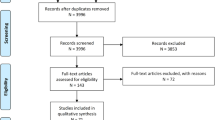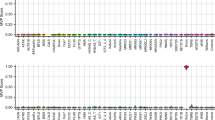Abstract
In 2007, the DYSCERNE pilot project funded by the European Commission Public Health Executive Agency (EU DG Sanco) aimed at setting up a network of expertise for patients with rare dysmorphic disorders. As part of DYSCERNE, a Dysmorphology Diagnostic System (DDS) was set up to enable clinicians throughout the EU to submit cases electronically for diagnosis using a secure, web-based interface, hosted at specified access points (Submitting nodes), in 26 different European countries. We report the outcome of this service for 200 cases submitted consecutively between January 2010 and 2012. Each case was reviewed by an average of five expert reviewers. An average of three possible syndromic diagnoses was suggested per case. In 22.5% of the cases, a consensus clinical diagnosis was reached. Genetic testing was suggested in 70.5% of the cases, whereas other laboratory investigations and diagnostic imaging were recommended in 35.5 and 26% of the cases, respectively. Further specialized opinions were suggested in 23.5% of the cases. Overall, a total of 181 very rare or extremely rare genetic syndromes were considered in the differential diagnosis of the 200 cases. In two cases, the reviewers suggested that the findings represented a new syndrome, and in one of these syndromes the underlying genetic cause was subsequently identified. Other benefits of the submission process included the possibility of directing the case submitters to specific centres for diagnostic testing or participation in research and educational benefit derived for both case submitters and reviewers.
Similar content being viewed by others
Log in or create a free account to read this content
Gain free access to this article, as well as selected content from this journal and more on nature.com
or
References
Mathews TJ, MacDorman MF : Infant mortality statistics from the 2003 period linked birth/infant death data set. Natl Vital Stat Rep 2006; 54: 1–29.
McCandless SE, Brunger JW, Cassidy SB : The burden of genetic disease on inpatient care in a children's hospital. Am J Hum Genet 2004; 74: 121–127, (Erratum in: Am J Hum Genet. 2004; 74: 788).
Moeschler JB, Shevell M, The American Academy of Pediatrics Committee on Genetics: Clinical genetic evaluation of the child with mental retardation or developmental delays. Pediatrics 2006; 117: 2304–2316.
DYSCERNE ® www.dyscerne.org Accessed on 13 November 2012..
London Medical Databases. Winter–Baraitser Dysmorphology Database www.lmdatabases.com Accessed on 15 April 2013..
Basel-Vanagaite L, Dallapiccola B, Ramirez-Solis R et al: The E3 ubiquitin ligase UBE3B is mutated in an autosomal-recessive blepharophimosis-intellectual disability syndrome. Abstract: 15th Manchester Dysmorphology Conference 2012.
Johns Hopkins University and National Center for Biotechnology Information. Online Mendelian Inheritance in ManTMwww.ncbi.nlm.nih.gov/omim Accessed on 15 April 2013.
Orphanet ® www.orpha.net Accessed on 15 April 2013..
POSSUM. Pictures of Standard Syndromes and Undiagnosed Malformations www.possum.net.au Accessed on 15 April 2013..
Reardon W, Donnai D : Dysmorphology demystified. Arch Dis Child Fetal Neonatal Ed 2007; 92: F225–F229.
Editorial: Can we all just get along? Nat Genet 2012; 44: 833.
Harris R, Reid M : Medical genetic services in 31 countries: an overview. Eur J Hum Genet 1997; 5 (Suppl 2): 3–21.
Zimmern RL, Khoury MJ : The impact of genomics on public health practice: the case for change. Public Health Genomics 2012; 15: 118–124.
Lu X, Shaw CA, Patel A et al: Clinical implementation of chromosomal microarray analysis: summary of 2513 postnatal cases. PLoS One 2007; 2: e327.
Rauch A, Wieczorek D, Graf E et al: Range of genetic mutations associated with severe non-syndromic sporadic intellectual disability: an exome sequencing study. Lancet 2012; 380: 1674–1682.
Dentici ML, Tarani L, Digilio MC et al: RDDR: a dysmorphology diagnostic network for newborns in central Italy. J Matern Fetal Neonatal Med 2012; 25 (Suppl 4): 121–123.
Donnai D : Genetic services. Clin Genet 2002; 61: 1–6.
Acknowledgements
The DYSCERNE project was funded by grants from the European Commission Public Health Executive Agency, the European Society of Human Genetics and the Manchester Biomedical Research Centre.
Author information
Authors and Affiliations
Consortia
Corresponding author
Ethics declarations
Competing interests
The authors declare no conflict of interest.
Additional information
Supplementary Information accompanies this paper on European Journal of Human Genetics website
Supplementary information
Appendix
Appendix
Members of the DYSCERNE expert panel:
Amiel J, Baraitser M, Brueton L, Brunner H, Chrzanowska K, Dallapiccola B, del Campo Casanelles M, Devriendt K, Donnai D, Fitzpatrick D, Gillessen-Kaesbach G, Houge G, Kerr B, Krajewska-Walasek M, Lacombe D, Meinecke P, Metcalfe K, Mortier G, Odent S, Philip N, Prescott T, Raas-Rothschild A, Rauch A, Rittinger O, Salonen R, Schrander-Stumpel C, Suri M, Temple K, Tolmie J, Van Der Burgt I, Verloes A, Wieczorek D and Zenker M.
Rights and permissions
About this article
Cite this article
Douzgou, S., Clayton-Smith, J., Gardner, S. et al. Dysmorphology at a distance: results of a web-based diagnostic service. Eur J Hum Genet 22, 327–332 (2014). https://doi.org/10.1038/ejhg.2013.137
Received:
Revised:
Accepted:
Published:
Issue date:
DOI: https://doi.org/10.1038/ejhg.2013.137
Keywords
This article is cited by
-
Telemedicine strategy of the European Reference Network ITHACA for the diagnosis and management of patients with rare developmental disorders
Orphanet Journal of Rare Diseases (2020)



